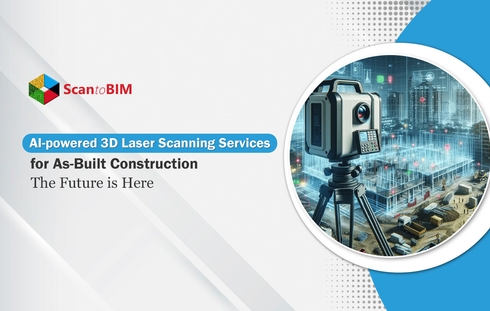
One of the biggest industries in the world economy- the Architecture, Engineering, and Construction sector, has long been associated with ambitious undertakings, intricate procedures, and interdisciplinary cooperation. Gradually, technology plays a profound role in this industry, becoming more productive and efficient with cutting-edge Scan to BIM services.
The industry is on the verge of a new revolution with the introduction of Artificial Intelligence (AI) into BIM and the use of technologies like AI-powered 3D laser scanning.
This strategy brings precision, automation, and improved decision-making processes to the AEC industry, allowing it to surpass old approaches.
Scan to BIM services entail creating a digital BIM model using comprehensive 3D data of an existing physical structure using scanning technologies such as drones, photogrammetry, or laser scanners.
By guaranteeing data accuracy, automating several manual operations, and creating new opportunities for intelligent decision-making, AI-powered Scan to BIM services are the evolving face of building-making.
Artificial Intelligence in Scan to BIM Services: Introducing Avant Garde Solutions
Although the core Scan to BIM process is already a significant leap forward, the integration of AI elevates it to a new level of efficiency and capability.
AI can be applied in various stages of the Scan to BIM workflow, particularly in automating processes, improving modeling accuracy, and offering predictive insights.
From Manual to Automated: Transforming Object Recognition
The manual conversion of the point cloud into a comprehensive BIM model is one of the most time-consuming steps in Scan to BIM. This entails locating and modeling distinct architectural elements including windows, doors, and walls as well as structural components.
Typically, a trained technician manually decipher the point cloud data to replicate these elements into a BIM program.
AI algorithms can be trained to identify patterns in point cloud data and automatically recognize structural elements, categorize them, and model them in BIM software with minimal human participation.
Minimising errors and maximising accuracy: Towards design excellence
By comparing scanned data with existing building designs or old models, AI ensures the accuracy of architectural Scan to BIM services. AI-powered services benefit renovation and restoration projects, bridging the gap between the existing structure and the original building designs due to changes made over time.
AI algorithms can detect differences between the scanned data and the original designs, highlighting potential issues for further investigation.
AI-powered Scan to BIM services automate repetitive tasks, design iterations, data alignment, and model validation, minimizing the probability of errors and design defects. Furthermore, conflicts, inconsistencies, and structural flaws can be maneuvered through AI-based quality control systems, overlooked otherwise.
Data Management and Interpretation: Re-configuring building management
Large-scale building projects generate massive datasets using architectural Scan to BIM services. Amalgamating AI can process and analyze these large datasets at a fast pace compared to manual conversion.
The user can evaluate and link the significant information extracted from point clouds with other datasets, such as construction specifications, regulatory frameworks, and geographic information systems (GIS).
Additionally, AI can assist with data compression while preserving essential features. The high-resolution point cloud files produced by scans require substantial computing power.
AI algorithms can intelligently compress these datasets, ensuring that only the most relevant data points are retained, which improves data handling and manipulation.
Predictive Analytics and Simulation: Getting ready for the future
AI-powered Scan to BIM services can do more than generate 3D models of existing structures. They assist in simulations and forecasting future events, including a building's aging process, pinpointing probable structural issues, and the potential effects of specific environmental factors on a project by evaluating current circumstances and utilizing past data.
Using Scan to BIM data as a source, AI-powered BIM systems can simulate various scenarios, assisting engineers and architects in determining whether design choices are feasible and streamlining the construction process.
Integrate AI-powered Services into AEC Projects: Conferring the Benefits
The integration of AI into Scan to BIM workflows brings numerous benefits to the construction industry, many of which directly address key challenges that have historically hampered productivity and project delivery.
- With AI-induced automation, labor-intensive tasks such as object recognition, data processing, and model generation can be smoothly executed.
- Project teams can direct the focus on more complex and value-adding tasks with time-saving 3D BIM modeling services, ultimately speeding up project delivery.
- Automating Scan to BIM processes through AI reduces labor costs associated with manual data interpretation and modeling and adheres to budget constraints.
- Scan to BIM facilitates better collaboration among project stakeholders, including architects, engineers, contractors, and clients, streamlining coordination through common data environments(CDEs) and collaborative platforms.
- By continuously monitoring building performance data and analyzing it in conjunction with the BIM model, AI systems can predict when maintenance will be required, helping to prevent costly repairs and extend the life cycle of the building.
Minimizing Human Intervention with Cutting-edge AI-induced Services
The in-house AI integrated services and quality assurance tools by ScantoBIM.online minimizes human involvement, ensuring consistent quality and on-time execution. The services facilitate generating precise architectural layouts and details, integrating the building with its surroundings.
One of the shining examples of AI-powered Scan to BIM services by ScantoBim.online is a USA- based commercial project that witnessed a 400,000 sq ft conversion in just 43 days, approximating to 9000 sq ft conversion daily.
The company has a pool of more than 150 dedicated architects and engineers who specialise in precise Scan to BIM services. The team is dedicated to provide tailored services to their clients in both ACS and MEPF disciplines.
Conclusion
The convergence of Scan to BIM services with AI is fundamentally changing the dynamics of building construction. By automating manual tasks, improving the accuracy of BIM models, and providing predictive insights, AI empowers construction professionals to deliver projects more efficiently and cost-effectively.
From renovation projects and infrastructure development to heritage conservation and facility management, the applications of AI-enhanced Scan to BIM services are vast.








